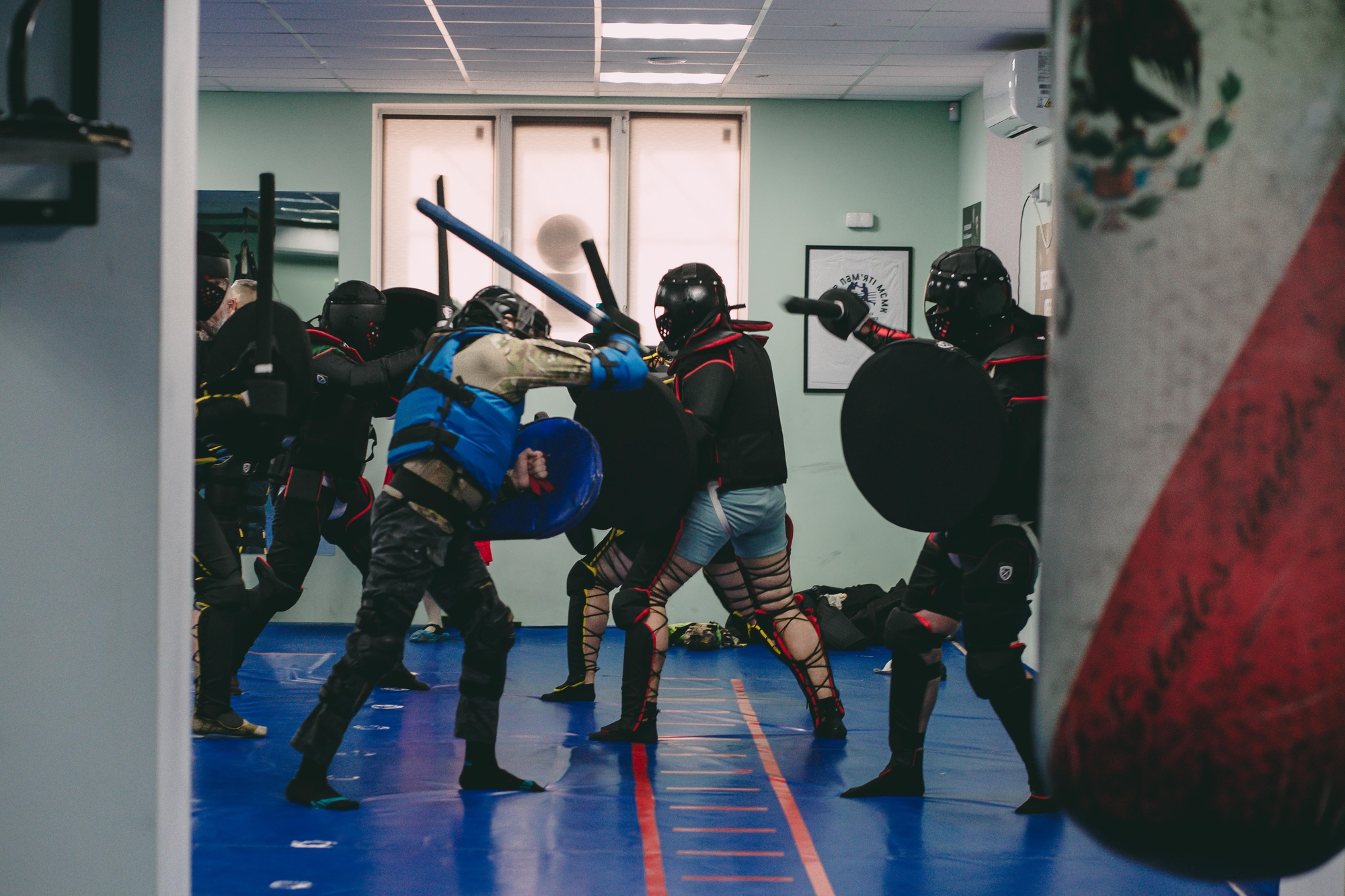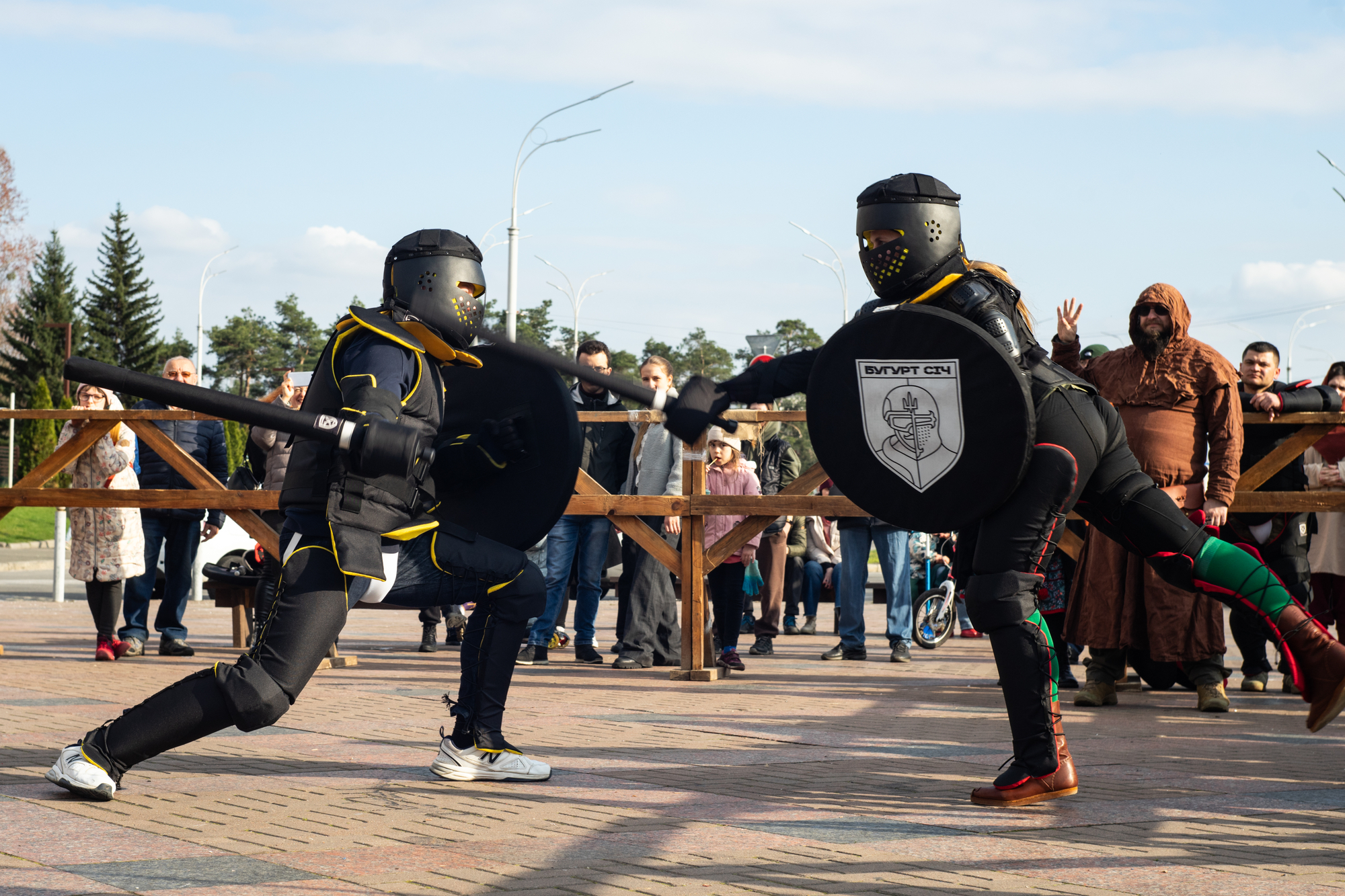They fight with swords to start living. How BugurtSich helps veterans with PTSD with medieval battles

Can medieval sword fighting help rehabilitate veterans?
Olena Krechet, co-founder and head of the NGO BugurtSich, is convinced that it does. Thanks to intensive team training, the military relieve tension and adapt to the civilian world, feeling the support of their comrades. They begin to tell their stories.
Currently, the BugurtSich team consists of 12 people, and about 200 veterans attend classes on a regular basis, including those in wheelchairs. There are three branches of BugurtSich in Kyiv alone, and two more in Ivano-Frankivsk and Odesa. There are plans to open in other cities as well: the demand is great.
LIGA.net talked to Olena and asked her what it was like to bring the military back to life with a sword and shield.
Bugurt overcomes PTSD
Olena Krechet has been involved in medieval battles for over 20 years. In the beginning, it was role-playing games at festivals. Olena and like-minded people learned to fight with swords, shoot archery, and build fortresses. But back then, it was more of a hobby and a hobby. It was only in 2016 that team battles in medieval armor, which are part of historical reenactments, were officially registered in Ukraine as a sport – bugurth.
"In 2020, fate brought me together with Ihor Parfentiev, the future co-founder of the BugurtSich project, a multiple world champion in bugurt sports and an ATO veteran," says Olena. "It all started with a conversation in which he told me that he had long been harboring the idea of an organization where other veterans could practice this sport and recover. I immediately realized that I wanted to be involved. I know what it's like when you've had a 'fight' and all your problems go away. That's how we started working."

Ihor told Olena about his friends from the United States who help local veterans overcome post-traumatic stress disorder (PTSD – ed LIGA.net) with the help of medieval battles, and even made a movie about it. Olena and Ihor had a rough idea of what to do, but not quite how.
They decided to act gradually and in 2021, together with several other ATO veterans, registered a non-governmental organization. That's where it all ended: the full-scale invasion began, and almost all of the project participants went to defend Ukraine. Olena became a volunteer, organizing fundraisers for her own, buying and sending the necessary items.
They returned to Buhurt Sich together in 2023, and then the question arose again: how exactly to rehabilitate the military with the help of medieval battles?
"In the United States, a lot of veterans practice medieval combat. However, there has been no research on the impact of combat on PTSD in the world," says Olena. "We knew intuitively that it helps. But how does it work? What are the mechanisms? We met pathophysiologist Viktor Dosenko, who studies PTSD. He said: yes, this is the best method of mental health, bugurt can fight PTSD. Viktor brought us to the Lisova Polyana rehabilitation center, where our defenders are recovering, and introduced us to the medical team. They said our idea was a biopsychosocial approach. That is, work on three levels simultaneously: psychological, social and physical. We listened to them. We said: "What?" And we continued to work."

Beginners fight for 30 seconds
Each training session begins with the veterans putting on lightweight fabric protective armor. They are given to all participants free of charge in BugurtSich. There are also metal ones, but they weigh between 17 and 30 kg: not everyone can wear them immediately after being wounded or contused.
"However, even in light armor, there is an intense cardio load," explains Olena. "A beginner, for example, is unlikely to withstand a fight lasting longer than one minute. Competitions between beginners last up to 30 seconds. Those with experience fight for a minute or more."
The training is structured according to the classic scheme: warm-up, active part and cool-down. If the coaches see that the group has come with different levels – some are apathetic, some are "wound up," then they do additional body-oriented practices during the warm-up.
"Psychologists help us here. We do breathing exercises and practice feeling our bodies and ourselves in the group," says Olena. "Then comes the active part: the battle itself. All participants take turns fighting several times, changing teams. We fight three-on-three: just for fun or with a goal. For example, to capture the enemy's flag. Victory is very important, but still not more important than the process. So we shout victory and continue. If someone gets sick – a panic attack, an attack of aggression or something like that – the psychologist helps them cope."
Training is always fun. Humor is blacker than coal:
"Soldiers with amputations joke that they don't need to have pedicures or buy socks. I heard one complain that his knees hurt. A guy with a high amputation replied: "I'm sorry, because mine don't hurt." Irony helps to perceive changes in the body."
Before a fight, veterans can be in different states, because each one lives through their own pain. During the competition, Olena says, they seem to wake up: they become active and excited. That's why after a fight, the changes can be dramatic: it often looks like a person has released tension and feels alive. Even a short period of time when a veteran can get away from his or her thoughts is an effective tool in overcoming PTSD.
"Our principle is equal to equal"
In the case of PTSD, a person is immersed in intrusive memories. Active work of the body during combat gives the brain a break from them. The veteran remembers that you can come to training, have fun, and it will become easier. In addition, bugurth is a squad-to- squad, wall-to-wall battle. It's a team sport that requires strategy and tactics. For the military, this is close and understandable.
"During their service, many soldiers find their closest people to be their comrades-in-arms – those who will always have their back, lend a shoulder, and understand. "Our sport has all of this," explains Olena. "Plus, most of the instructors at BugurtSich are veterans, and we work on the principle of equal to equal. If a fighter with an amputated arm enters the ring (the place where fights are held – LIGA.net), his opponent will put up a shield. If he is in a wheelchair, the other will sit on a chair."

In addition to training, BugurtSich organizes lectures, Sich vatras (one-day outings with a big bonfire), and retreats (trips for several days). At these events, participants study Ukrainian history, learn calligraphy, get acquainted with ancient musical instruments, and cook according to recipes that are hundreds of years old.
For example, during lectures, veterans are told that chivalry as a phenomenon existed not only in Europe. There were knights in Ukraine as well.
"A few lines in a 5th grade history textbook was all we knew about Kyivan Rus," Olena says. "Yes, chivalry was not a mass phenomenon here. However, there were knights, but almost no one knows about them. We are closing these gaps."
How the Buhurt Sich is organized
Today, BugurtSich is a stable team of 12 people: coaches, psychologists, and administrators. The organization is funded through grants, so all activities are free for veterans. About 20 more people join as volunteers. Some of them are veterans who participated in combat but want to be more involved. They help with the organization and conduct master classes for others. About 200 people regularly attend training in all BugurtSich branches.
Currently, BugurtSich conducts training for veterans at hospitals and rehabilitation centers in Kyiv, Odesa, and Ivano-Frankivsk. The plans include Zvyagel, Vinnytsia, and other localities where there is a demand for medieval battles for veterans. Usually, after rehabilitation in Kyiv, veterans go home. They want to continue training there, and that's how the request comes about.
In addition to training, BugurtSich conducts numerous psychological studies of the impact of buggery on veterans' psyches and plans to publish the results later. According to Olena, the experience of BugurtSich is being adopted by foreign organizations.
"You know, I slept today."
After training, soldiers often start talking. Even those who have been captured and tortured:
"We don't leave after the fights. We stay and just listen," says Olena. "The instructors can also tell us something interesting: what kind of competitions there are, how to join, how everyone can develop in this sport. Because if a person starts to dream, he or she heals and integrates into civilian life."

Olena says that progress is noticeable after the first two or three sessions. She gives an example of one of the veterans who had multiple injuries, hadn't slept in weeks, and was silent all the time.
"I came to a few training sessions. And suddenly I see: he started smiling. Then he started laughing. Then he started talking. He said to me: "You know, I slept today," Olena recalls.
Another story happened during a Sich bonfire when Olena was cooking borsch. A veteran came up to her and suddenly asked her sharply: "Why are you doing this? Why are you doing this?" He came up with these questions several times, becoming more and more irritated each time. Once again, Olena answered with a question: "Do you want borscht?".
"He said: "Yes, I will." And then immediately: "No, don't. "In the end, he took a bowl. He was eating and eating, and suddenly threw the borsch into the fire. I told him to go to the gym and release his tension there. So he went. He comes back and is already calm: "When's the next time? It's so cool here..." We accept everyone as they are. I think this also has a therapeutic effect."
Olena believes that medieval combat can help reach veterans. To help them feel themselves, feel life, and start their journey back to civilian life:
"Our work is hard. It simultaneously takes away resources and gives them. Do you know which veterans are the happiest? Those who are in wheelchairs. After a battle, they shine with joy. But at first it is difficult for us to accept this. Because you see tough warriors whom circumstances have made so... We give them the opportunity to feel like they are in battle again. They are happy. We look at this joy and are ready to experience it again and again. As long as it takes".
The material was created by LIGA.net is supported by the Askold & Dir Foundation, administered by ISAR Ednannia as part of the project "Strong Civil Society in Ukraine – Driving Reforms and Democracy" with funding from Norway and Sweden. The content of this publication is the responsibility of LIGA.net and do not reflect the views of the governments of Norway, Sweden or ISAF Ednannia.





Comments (0)